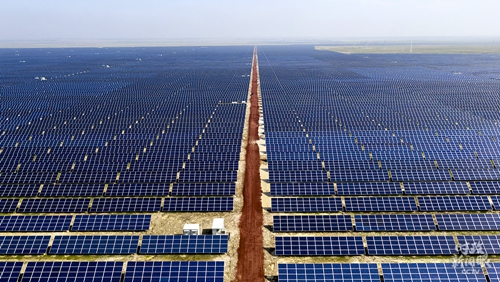According to a research published in May by the British University of Sheffield and, more specifically, according to the report ‘In Broad Daylight. Uyghur Forced Labour and Global Solar Supply Chain’ by the Helena Kennedy Centre, China is using Uyghur ethnic minority in Xinjiang in companies that fabricate essential parts (polycrystalline silicon) for the production of photovoltaic panels compelling them to a forced and underpaid labor.
According to this report in 2020 the world market of polycrystalline silicon was produced by 25% in other countries, by 30% in mainland China and even by 45% in Xinjiang, the region occupied by Uyghurs in Northwest China. Laura T. Murphy and Nyrola Elimä, authors of the report, invited in their publication to boycott the Chinese “illegal” (according to their report) production.
‘In Broad Daylight’ says: “The People’s Republic of China (RPC) installed millions of indigenous Uyghur and Kazak citizens of the autonomous Uyghur region of Xinjiang (XUAR or Uyghur region) in something that the Chinese government calls programs for the “surplus work” (富余劳动力) and “manpower transfer” (劳动力转移). An official report of the RPC government published in November 2020 evidences the “placement” of 2,6 millions of minority citizens in farms and factories workplaces in the Uyghur region and in all the country through these ventures of “surplus work” and “manpower transfer” sponsored by the State. The government states that these programs are legal according to the RPC law and that the workers are voluntarily employed, in a focused attempt supported by the government in order to mitigate the poverty. By the way the report keeps saying that some government and company’s sources are willing to prove that “the manpower transfers are unfolded in the Uyghur region in an absolute coercive environment supported by the constant threat of the reformation and internment. Many indigenous workers cannot reuse or leave these jobs so these programs are just a coercive transfer of people and slavery”.
It also states: “We concluded that the solar industry is particularly vulnerable to the forced labor in the Uyghur region because:
- 95% of the solar panels are made of a primary material: the polycrystalline silicon.
- The producers of the polycrystalline silicon in the Uyghur region represent about 45% of the world providers of this specific material.
- All the producers of polycrystalline silicon in the Uyghur region reported their participation to programs of manpower transfer and/or they are supplied by companies that produce raw materials using these programs.
- In 2020, China produced its own 30% of the world market of polycrystalline silicon beyond the amount coming from the Uyghur region, a significant percentage.”.
In the end, without the need of keeping mentioning this British report, the accusations to China are loud and clear.
The consequences suddenly conditioned the world photovoltaic market. Inevitably even the political world opposed to China partially boycotted the Chinese products, using this situation on purpose for a political issue. This happened also with the cotton when big companies like Nike and H&M chose not to buy Chinese raw materials anymore but, later, they stated that they did not want the politics enter in their marketing.
When and if these situations happen, the consequences on the economy, the cooperation and the labor market are devastating.
The British press agency Reuters stated that the UN has trustworthy proof about the secret internment of millions of Uyghurs but we should consider the fact that the Committee of the Elimination of All Forms of Racial Discrimination or even just a single member of it could not speak for the entire UN.For this reason, even the Helena Kennedy Centre could not be absolutely trustworthy. We should verify all the reports, especially if it could damage the international relationships.
We should not forget that in July 2019, 37 countries such as Saudi Arabia, Egypt, UAE, Sudan, Angola, Algeria, Nigeria, DRC, North Korea, Serbia, Russia, Venezuela, Philippines, Myanmar, Pakistan and Syria signed a joint letter to the UNHRC praising China for its remarkable results in Xinjiang. Later the ‘Global Times’, a Chinese public tabloid, confirmed that 50 countries such as Iran, Iraq, Sri Lanka, Djibouti and Palestine signed the letter.
Furthermore, in November 2019, before the Covid-19 pandemic, the UN published a full list of 54 countries that supported the Chinese politics in Xinjiang.
There is much talk about the ‘centers of reformation’ that China built in order to limit and correct people who took part of terrorist attacks.
Since 2017, local media generally has been referring to this structures as “centers of formation against the extremism” (去极端化培训班) and “centers of formation for the instruction and the transformation” (教育转化培训中心). Most of these structures were made out of former schools or official buildings even if some of them were built just for “reformation” purposes. These centers were accused by those who blame China of being just an excuse to intern the Uyghurs until their elimination.
Of course, the production of polycrystalline silicon in China and more specifically in Xinjiang is so huge that requires so much manpower. All of this obviously means occupation and fighting against the unemployment. Furthermore it seems that the workers in these factories are specialists, highly skilled and with technical capabilities. Should we believe that in 2021 still exists a skilled worker who accept a forced labor? Maybe it could happen because of economic problems but it probably would be a single case. It is not easy to believe that masses of skilled workers accept awful working conditions, if not for a good salary. Furthermore, in the internet age it is hard to believe that it is not possible to share in the social media or elsewhere this eventual barbarity.
Cheng Jingye, the Chinese ambassador in Australia, denied the news about a million Uyghurs arrested in Xinjiang and he underlined the fact that what happened in Xinjiang is not far from what happens in other countries, even the Western ones, in order to fight the terrorists.
We know that nowadays China is one of the most polluted countries but we know as well that recently Xi Jinping, the Chinese president, announced his willing to transform China in carbon neutral country within 2060. This means a lot about the Chinese willing to grow and do something also for the necessities of our planet, speaking about renewable energy and economic, political and cultural choices.
As the Institute for the International Politics Studies reports, “the goal of the carbon neutrality requires a drastic transformation of the Chinese economy: nowadays the fossil energy represents 85% of the energetic needs of the country, while the renewable 15%. China is the bigger coal consumer worldwide, with a percentage of 50,2%. This is a huge percentage considering that the second biggest consumer, India, represents 11,3% of the total while in the third place we find the USA with a percentage of 8,3%. Actually, the coal is still necessary for the Chinese economy: it represents 58% of the energy needs and 66% of the electric production.”.
But the Ispi also confirms that “the country is not backward: it produces 30% of the electric energy from renewable sources worldwide. It is leader in the clean energy technologies – including solar and wind – and the biggest producer of electric cars and buses worldwide. China produces about 70% of the solar panels and almost half of the wind turbines worldwide. It also builds 70% of the lithium batteries and dominates the biggest part of the extraction of the rare earth elements indispensable in the electricity sector. Furthermore, Beijing could adopt politics for the reforest and the reduction of CO2 emissions through new technologies for capturing and storing the coal.”.
Among the big countries, it is growing what ‘The Diplomat’, newspaper focused on Southeast Asia, calls the ‘clean technology rush”. The online newspaper wrote that nowadays China dominates the solar panels market thanks to low-cost devices bought with the funds of the State-Part and it stated that a “fair” competition between America and China could lead to a reduction of the costs of the clean technologies and the greenhouse gases emissions, for the good of all.
We should not forget that in 2020 China became the first commercial partner of the EU, data that was confirmed even after the treaty on the investments signed by Bruxelles and Beijing. Before the Covid-19 pandemic spread, Italy and China had already embarked on a very important path of collaboration. The so-called ‘New Silk Road’ created in 2013 by Xi Jinping, the Chinese president, in late 2019 had a boom after the visit of Luigi Di Maio, Minister of Foreign Affairs and person in charge also for international commerce, who flew to Shanghai in order to participate to the China International Import Expo. There were defined new important aspects of this collaboration that aims to increase the commerce and the market between China and Europe and obviously Italy. Furthermore, among thousands of tragedies and difficulties caused by the pandemic, Italy and China figured out how to increase a useful cooperation that convinced 36% of the Italian population to consider China as the main strategic partner. The SWG survey, relating to the first days of April 2020, showed that a minor percentage of just 30% was instead considering the US as a ideal partner. The remaining percentage represented those who were hesitant between the two parts.
In the end, Italian people are much closer to China sharing this sanitary emergency and look at it with more confidence than in the past.
Even in this situation, focusing on the photovoltaic sector, so prolific and promising, it is not useful to trust the reports that blame China so hard.
It is logical to ask if even this time, just like already happened in the past, an American strategy is just trying to focus the attention on political matters with the aim of enlighten single events and taking advantage of them. Is all this sudden attention for one of the 56 ethnic minorities officially recognized by the Chinese Communist Party sincere?
If many international reports blame Beijing of arbitrary detention in camps of “reformation”, mass surveillance and forced sterilization for at least a million people of this Muslim minority, we should consider if all of this could hide an ulterior motive. That’s why pure political issues should never be mixed with the economic ones in order to safeguard the international cooperation between countries or even continents.
Another question should be: can we check the sources so deep? Can we draw our conclusions without thinking that some eventual and unpleasant episodes are just generalized?
And last but not least, are we sure that the injustices and violations happen only in Xinjiang? What is the difference between what happens to the Uyghurs and what happens even in some Western countries? How many hours do we work every day? How much do we earn? What do they teach us? How to give the right value to our work for being humans? Should Italy and all Europe necessarily support the ideology of the United States or in this particular case of the British report of the Helena Kennedy Centre?
Beijing swears this is not forced labor.
PV Magazine reported that few weeks ago Daqo New Energy Corp, a company that produces polycrystalline silicon opened his factory in the city of Shihezi, in the autonomous region of Xinjiang, to the institutional investors and the analysts of the solar sector. PV Magazine reported the statements of the Chinese producer:
“The analysts of the solar sector from Credit Suisse, CICC, Goldman Sachs, HSBC, JP Morgan and seven institutional investors joined a live tour of the innovative structures of the Company.”.
In the same article it is also reported that the journalists of several media such as Bloomberg, Financial Times and China’s Global Times were among the observers.
“Just like we stated several times, we do not tolerate the forced labor in any case.” Longgen Zhang, the CEO of Daqo, reported to the same magazine. “Furthermore, our visitors could see that our chemical process is highly automated, digitalized and intensively technology-based and it does not suit no-skilled manpower”. Last January, at the time of the first accusations, Daqo had already stated: “The company considers the idea of ‘forced or jail labor’ ethnically disgusting and also absolutely incoherent to its goals in order to succeed in terms of safety, efficiency and costs.”.
In some cases the proof of the accusations against China came from sources that talk about tortures, forced abortions, violence and abuses with the goal of the extinction of the Uyghurs and the other ethnic minorities.
We all agree that any kind of violence, no matter in which form and who is the oppressor, should be blamed but we should also understand if these accusations are useful in order to build a better world with no ulterior motive or if these are generated only for political or strategic reasons.
It is necessary to keep safeguarding the human rights and at the same time protect and feed a cooperation between the countries, in this case Europe and China, in order to pursue a real and complete development.
Only the support of any country and to all the countries with their own peculiarities, capabilities and competences could really lead to a useful development for everyone.
In particular, in the photovoltaic sector, China is the biggest provider of photovoltaic cells, the ones that form the solar panels. In fact it dominates the sector of the supplying of the raw materials and the indispensable components for the production of the panels. Europe has instead a wider technological knowledge useful for the development of the Chinese companies.
An exchange and a fair cooperation, just like already happened in the past in other sectors, can work even in the photovoltaic one and it can undoubtedly make the difference, building a better future for everyone.
Article by Donatella Briganti. All views expressed are the author’s personal. Epistle News editorial board was not involved in the making of this article.



